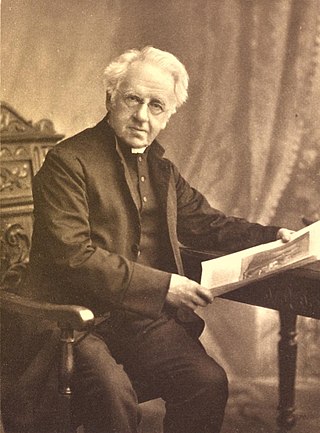
Frederick Donald Coggan, Baron Coggan, was the 101st Archbishop of Canterbury from 1974 to 1980. As Archbishop of Canterbury, he "revived morale within the Church of England, opened a dialogue with Rome and supported women's ordination". He had previously been successively the Bishop of Bradford and the Archbishop of York.

Thomas Beccon or Becon was an English cleric and Protestant reformer from Norfolk.

The Diocese of Southwark is one of the 42 dioceses of the Church of England, part of the worldwide Anglican Communion. The diocese forms part of the Province of Canterbury in England. It was created on 1 May 1905 from part of the ancient Diocese of Rochester that was served by a suffragan bishop of Southwark (1891–1905). Before 1877 most of the area was part of the Diocese of Winchester, some being part of the Diocese of London.

The Episcopal Diocese of Vermont is the diocese of the Episcopal Church in the United States of America in the state of Vermont. It was the first diocese in the Episcopal Church to elect a woman, Mary Adelia Rosamond McLeod, as diocesan bishop.
Saints in Christianity are a people recognized as having lived a holy life and as being an exemplar and model for other Christians. Beginning in the 10th century, the Catholic Church began to centralise and formalise the process of recognising saints through canonisation.
The Society of St John the Evangelist (SSJE) is an Anglican religious order for men. The members live under a rule of life and, at profession, make monastic vows of poverty, celibacy and obedience.

Richard Meux Benson was a priest in the Church of England and founder of the Society of St. John the Evangelist, the first religious order of monks in the Anglican Communion since the Reformation. He is commemorated in the Calendar of Saints of the Anglican Church of Canada on 15 January and on the Episcopal Church calendar on January 14 with Charles Gore.

Thomas Coke was the first Methodist bishop. Born in Brecon, Wales, he was ordained as a priest in 1772, but expelled from his Anglican pulpit of South Petherton for being a Methodist. Coke met John Wesley in 1776. He later co-founded Methodism in America and then established the Methodist missions overseas, which in the 19th century spread around the world.

Marvil Thomas Shaw III was an Episcopal bishop based in New England and a member of the Society of St. John the Evangelist. In 1995, he was called as the fifteenth Bishop of Massachusetts.
Henry Robert Kingscote was an English philanthropist and amateur cricketer who played first-class cricket from 1825 to 1844. He was a founding director of the South Australian Company, and also founded several charitable organisations, churches and schools.
Spence Burton was an Anglican bishop in the mid 20th century and the first American to be consecrated a bishop in the Church of England.
John Garnett (1707/08–1782) was an English bishop of Clogher in the Church of Ireland.
Kenneth Abbott Viall was born in Lynn, Massachusetts as the only son of Frederick Clarence Viall and Edith Laura (Robbins) Viall. He received his A.B. from Harvard College in 1915, and B.D. from the General Theological Seminary, New York, in 1919. He received an M.A. from the Harvard Graduate School of Education in 1920, and an Ed.M. in 1921. He received an honorary S.T.D. from General Seminary in 1949.

The Church of St Stephen and St Thomas is a Church of England parish church in Shepherd's Bush, London. It was built circa 1849–50, designed by architect Anthony Salvin in the Gothic Revival style and is now Grade II listed. The church is located on the South side of Uxbridge Road on the corner of Coverdale Road, to the west of Shepherd's Bush tube station.
William Henry was an Anglo-Irish Anglican priest, who became Dean of Killaloe and Fellow of the Royal Society.
George Yemens Bliss was an American cleric who was the coadjutor bishop of the Episcopal Diocese of Vermont, serving from 1915 until his death in 1924.
The Church of England Record Society is a text publication society for the history of the Church of England. It was established in 1991. The society has published an annual volume since 1994, the first being Kenneth Fincham's Visitation Articles and Injunctions of the Early Stuart Church. The society is a registered charity.

George Rundle Prynne (1818–1903) was a British Anglo-Catholic cleric in south-west England, known for his Tractarian and ritualist views. He is also notable as a hymn-writer: his "Jesu(s), Meek and Gentle" ranked with "Jesus Loves Me" and "Near the Cross" for American Protestants in the later 19th century".
Gabriel Clark D.D., was an English Anglican priest in the 17th century.
Oliver Sherman Prescott was a prominent American Anglo-Catholic priest and activist who was active in the foundation of the Society of St. John the Evangelist. He was born in New Haven, Connecticut, and baptized by Harry Croswell at Trinity Church on the Green in that city. Prescott attended Trinity College, Hartford from 1840 to 1842 and Yale College from 1843 to 1844; he was graduated from the General Theological Seminary in New York in 1847 and made a deacon that year at Trinity Church in New Haven. He considered himself a protégé at the General of Professor Clement Clarke Moore.









